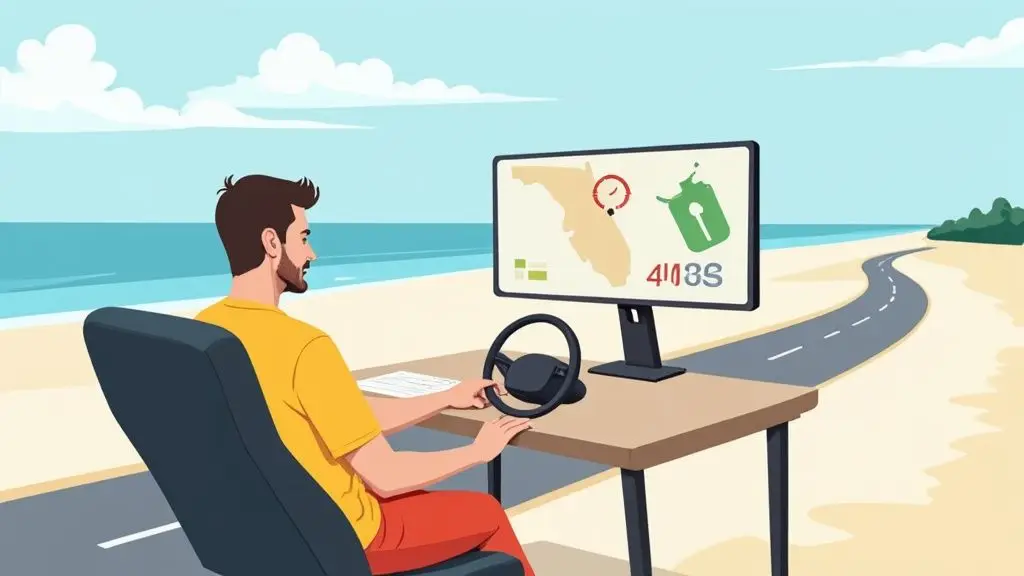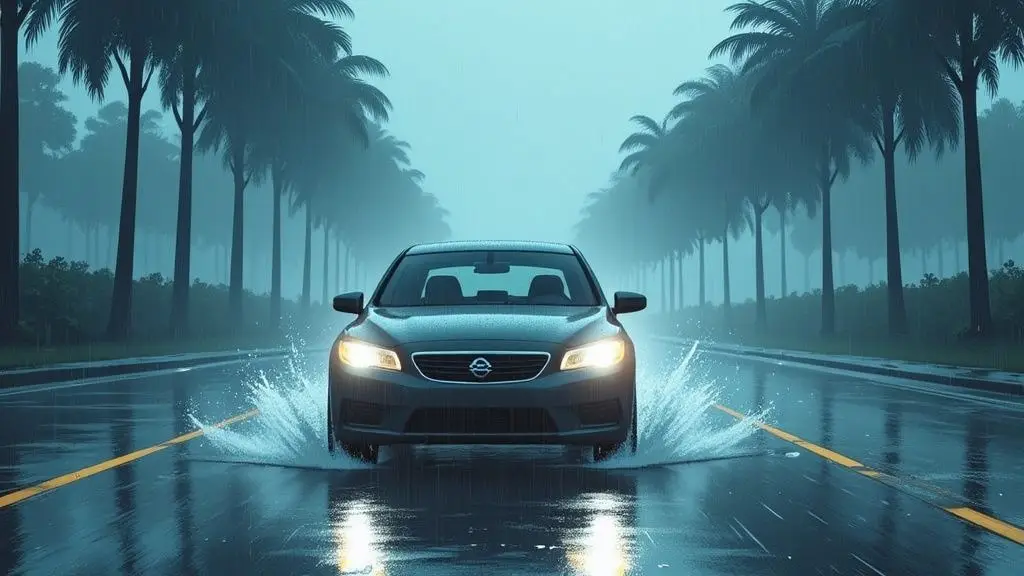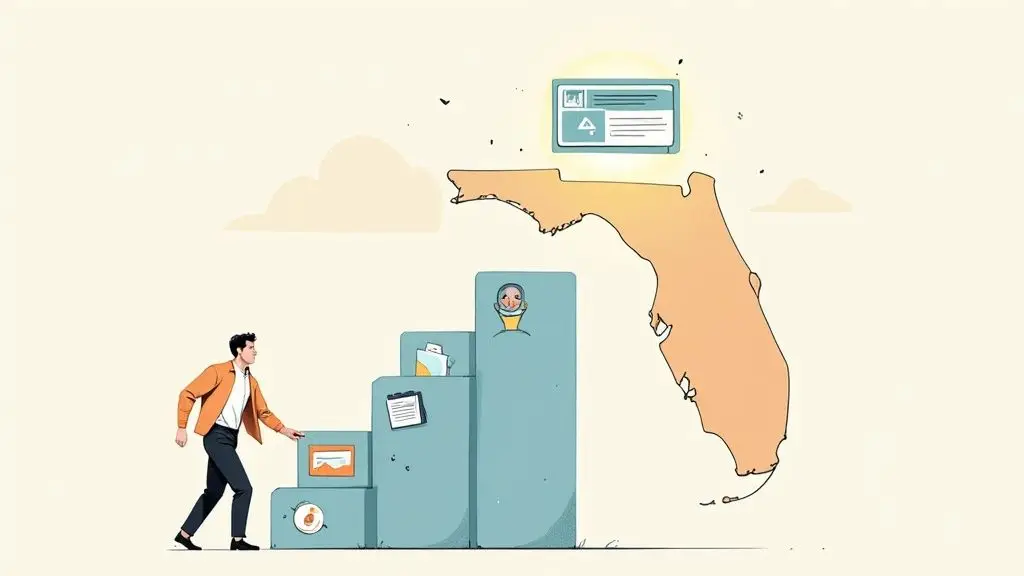When you drive in Florida, you probably notice the speed limit signs. These signs show the fastest speed you can go. But the most important rule isn’t on a sign. It is called Florida’s “basic speed law.” This law is all about using good judgment.
In short, this law says you must always drive at a safe speed. The speed should be reasonable for the conditions you see. This is true even if the sign says you can go faster.
The Foundation of Florida Speed Laws
Think of the posted speed limit as the top speed for perfect conditions. This means clear skies, dry roads, and not much traffic. Consequently, the sign does not show a speed you have to reach. The law actually requires you to slow down when things are not perfect.
This is the most important part of traffic safety in Florida. For example, imagine you are driving on I-95 at 70 mph during a heavy rainstorm. You could be breaking the law. Even though the sign says 70, that speed is not safe or “prudent” when you can’t see well. The road is also slippery. The same idea applies to rush hour traffic, construction zones, or foggy mornings.
To help drivers, Florida also has statutory speed limits. These are default speeds for when you do not see a sign. They give drivers a clear starting point for different areas.
What is the Basic Speed Law?
The Basic Speed Law is more than a suggestion. It is written in the state statutes. The law puts the responsibility on you, the driver. You must look at the situation and drive at a safe speed.
Here is a look at the official language from the statute itself:
This legal text simply means you cannot drive faster than what is reasonable. You must think about any “actual and potential hazards.” Learning this simple rule is the first step to becoming a truly safe driver.
Florida Statutory Speed Limits At a Glance
So, what should you do when there is no speed limit sign? This is where statutory limits are important. Think of them as the default settings for Florida’s roads.
This table gives you a quick summary of the default speed limits. Remember, if you see a sign with a different number, you must follow the sign.
| Location Type | Statutory Speed Limit (MPH) |
|---|---|
| Municipal/Business/Residential Area | 30 |
| County Roads and Highways | 55 |
| Rural Interstate Highways | 70 |
| Limited Access Highways | 70 |
Ultimately, both the basic speed law and these default limits work together. They are designed to prevent collisions. As the Florida Department of Transportation (FDOT) states, speed is a major factor in road safety. In addition, data from the National Highway Traffic Safety Administration shows that speeding is a cause in many deadly traffic incidents across the country.
Following these basic rules is not just about avoiding a ticket. It is about protecting yourself and everyone else on the road.
Why Do We Even Have Speed Limits in Florida?
Speed limits are a normal part of driving. As a result, we rarely think about why they exist. But the history behind them is interesting. It is a story about balancing speed with safety. Understanding this history helps explain the florida speed limit laws we follow today.
The idea of limiting a vehicle’s speed is very old. The first speed limit in the U.S. was not set for modern cars. It was set in 1901. Connecticut was the first state to do this. The limit was a speedy 12 mph in cities. It was 15 mph on country roads. That is very different from what we see on highways today!
This image of a Florida street shows how normal speed limit signs are.
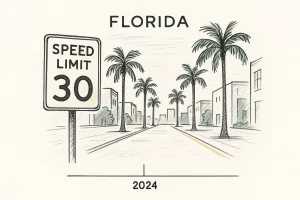
They are so common that we may not notice them. Still, these signs are a quiet reminder of the rules that keep us safe.
A National Crisis, A National Rule
For a long time, each state set its own speed limits. That changed in the 1970s. The 1973 oil crisis caused a national panic. There were long lines at gas stations. Everyone needed to save fuel. Therefore, President Richard Nixon signed the National Maximum Speed Law in 1974.
Suddenly, the whole country had a new speed limit. It was 55 mph. The main goal was to save gas. However, the law had a huge, life-saving result. Safety experts were surprised to see highway deaths drop quickly.
For example, the traffic death rate was 4.28 deaths per million vehicle miles in 1972. By 1983, after years of the 55 mph limit, that number fell to 2.73. This showed that slowing down did not just save fuel. It also saved thousands of lives.
This discovery changed everything. The focus shifted from saving gas to public safety. This focus is still the foundation of traffic law today. The Federal Highway Administration (FHWA) has many resources on how these early laws shaped modern road safety.
States Take Back the Wheel
The “double nickel” speed limit was the law for over 20 years. But many people felt it was too slow. This was especially true for those driving in the wide-open West. In 1995, Congress repealed the national law. This gave the power to set speed limits back to the states.
Florida quickly made changes. State lawmakers raised the speed limits on major highways. For instance, I-75 and I-95 became 70 mph. This is the speed most of us see on those roads today. The goal was to find a modern balance. It was about keeping traffic moving well while using the safety lessons learned over the years.
The history of florida speed limit laws is about constant change. It is shaped by national events and new car technology. It is also shaped by safety research. Groups like the Insurance Institute for Highway Safety (IIHS) study the link between speed and crashes. Their data helps lawmakers improve the rules of the road to keep us all safer.
Understanding Florida’s Special Speed Zones
Florida has special zones with different rules. These areas protect the most vulnerable people on our roads. If you are a Florida driver, you must follow these rules. It is not just about avoiding a big fine. It is about keeping people safe.
The two main zones are school zones and construction zones. In these areas, the normal rules change. Slowing down is not a suggestion. It is a must. Driving too fast in one of these zones puts lives at risk. It can also double the cost of a speeding ticket.
The Absolute Importance of School Zone Safety
We have all seen the flashing yellow lights of a school zone. When those lights are on, you must be very alert. Florida law lowers the speed limit to 15 or 20 mph. This is during the posted hours when children are present.
Why so slow? It is about simple physics. At 20 mph, your car can stop very quickly. At 40 mph, it takes much longer to stop. That difference can be life or death if a child runs into the street. The National Highway Traffic Safety Administration (NHTSA) says lower speeds are the best way to protect young pedestrians.
Navigating Construction and Work Zones
Construction zones also require your full attention. Think of it as driving through someone’s office. Workers are often just a few feet from your car. The speed limit is lower to give you more time to react. You might see lane shifts, heavy machines, or a worker in your path.
The Florida Department of Transportation (FDOT) works hard to make these zones safe. However, it is up to drivers to do their part.
This FDOT image is a clear reminder. You need to be focused to keep yourself and road crews safe.
Also, remember Florida’s Move Over Law. It is not just for police cars and ambulances. The law also applies to stopped construction, utility, and sanitation vehicles. If their warning lights are on, you must move over a lane. If you cannot move over safely, you must slow down to 20 mph below the posted speed limit.
Why the Penalties Are So Much Higher
Florida is very serious about these protected zones. The state doubles the fines for speeding in a school or construction zone. This sends a very clear message.
This is not a small penalty. A ticket that might cost $150 on a regular road can become $300 or more. That is before any court costs. It is a serious financial penalty designed to make you pay attention.
To give you a better idea, here’s how quickly those fines can grow.
Penalties for Speeding in Special Zones
This table shows how much more a ticket costs in a school or construction zone.
| Violation | Typical Fine | Fine in School/Work Zone |
|---|---|---|
| 1-9 MPH Over Limit | ~$80 | ~$160 |
| 10-14 MPH Over Limit | ~$155 | ~$310 |
| 15-19 MPH Over Limit | ~$180 | ~$360 |
Note: These fines are estimates and can vary by county.
The state’s message is clear. The safety of children and road workers is a top priority. If you get one of these citations, you should know what to do next. An approved online traffic school course can often help you understand your options. It may also help keep points off your license.
Residential Areas and Business Districts
Finally, remember the default speed limit in any residential or business area. It is 30 mph, unless a sign says otherwise. These areas have pedestrians, cyclists, and parked cars. Sticking to 30 mph is just common sense. It helps prevent a tragic incident in your own community. In addition, research from the Federal Highway Administration (FHWA) confirms that managing speed in local areas is key to public safety.
The Real Cost of a Florida Speeding Ticket
Getting a speeding ticket in Florida is stressful. But the fine is just the beginning. The mistake can affect you for years. It impacts your money, your license, and your insurance rates.
Understanding the full cost helps you see why Florida speed limit laws are strict. The consequences are not just for punishment. They are a serious reminder about the responsibility of driving.
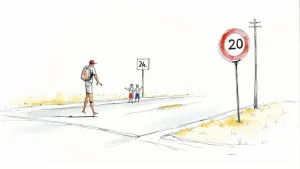
How Florida Calculates Speeding Fines
The first cost is the fine itself. It is not the same for everyone. Florida’s system is clear. The faster you drive, the more you pay.
Think of it as a scale. If you are only 1 to 9 mph over the limit, the fine might be small. But if you are 15 mph over, the cost goes up a lot. And if you speed in a school or construction zone, the fines are doubled.
Understanding the Florida Driver’s License Point System
Besides the fine, every speeding ticket adds points to your driving record. This is where the long-term problems start. The Florida Department of Highway Safety and Motor Vehicles (FLHSMV) uses this system. It tracks driving habits. These points show you are a higher-risk driver to the state and insurance companies.
How many points you get depends on your speed:
- 1 to 15 mph over the limit: 3 points
- 16 mph or more over the limit: 4 points
- Speeding that causes a crash: 6 points
These points stay on your record for years. They are what insurance companies look at when they set your rates.
When Speeding Becomes a Criminal Offense
Sometimes, speeding is more than a simple traffic ticket. It can become a criminal charge. If a police officer thinks your speed was very dangerous, you could face a reckless driving charge. This is not just a ticket. It is a misdemeanor with bigger penalties, including possible jail time and a criminal record.
A reckless driving conviction is a permanent mark. It can affect job opportunities, especially for jobs that require driving. It will also make your insurance rates go up a lot.
It is also important to know that driving 50 mph over the limit is very serious. This “dangerous excessive speeding” can lead to a required court appearance. It can even lead to jail time.
The Lasting Impact on Your Car Insurance
Perhaps the biggest financial hit from a speeding ticket is on your car insurance. When points are added to your license, your insurance provider sees you as a bigger risk. As a result, they raise your premiums.
This increase can last for three to five years. This means one ticket could cost you hundreds or thousands of extra dollars over time. This “hidden cost” is often much bigger than the original fine. If this happens to you, it is smart to see what you can do. For example, learning about classes for traffic tickets can help you deal with points and insurance hikes.
The Great Highway Speed Debate in Florida
Have you ever wondered who decides the speed limit on highways like I-75? That 70 mph sign is not a random number. It is the result of a long debate in Florida. It is a balance between getting to places quickly and keeping everyone safe.
The purpose of a 70 mph limit is to create a steady flow of traffic. When everyone moves at a similar speed, traffic is smoother. This means fewer people changing lanes or braking suddenly, which can cause pile-ups. It is a basic rule of traffic engineering: steady flow equals safety.
This is the kind of road where the debate happens. It is long, straight, and open.

Looking at a highway like this, you can see both sides. Your modern car can go faster. But what happens if something goes wrong?
The Push for 75 MPH
For years, there has been talk in Tallahassee about raising the speed limit. Some want to raise it to 75 mph on certain highways. This is a big change that affects how we manage our roads.
People who support the increase have a good point. Cars are much safer now. They have features like anti-lock brakes and stability control. They argue that a higher limit would just make the speed many people already drive legal. This could make traffic flow even smoother.
Why Sticking with 70 MPH Has Strong Backers
On the other hand, safety experts and police want to keep the limit at 70 mph. Their reason is simple physics. When you go faster, the force of a crash increases a lot. A crash at 75 mph is much more violent and deadly than one at 70 mph.
The National Highway Traffic Safety Administration (NHTSA) has clear data. They found that speeding was a factor in 29% of all traffic deaths in 2022. This statistic is a serious reminder that speed kills.
People against the change also say that higher speeds give you less time to react. Even with the best brakes, you have less time to stop for a problem on the road. This is a key point that groups like the Insurance Institute for Highway Safety (IIHS) often make in their research.
A Long History of Legislative Back-and-Forth
This debate is not new. In 1995, the federal government let states set their own speed limits. Florida acted quickly to raise them. But every attempt to go past 70 mph has failed. A major bill to raise the limit to 75 mph passed in 2014. However, the governor vetoed it because of safety concerns.
This shows Florida’s careful position. The topic comes up every few years. But lawmakers always have to weigh faster travel times against the data linking higher speeds to deadlier crashes.
In the end, this debate is about finding the right balance between speed and safety. The result affects every driver. It influences your daily commute and the points on your license. If you are curious about those points, our guide on the speeding ticket point system in Florida explains it all.
Common Questions About Florida Speed Laws
Driving in Florida can bring up a few questions. Even if you know the basics, you might face a situation that makes you wonder what to do. Let’s answer some of the most common questions drivers have about Florida speed limit laws.
Getting clear answers helps you drive with more confidence. It also helps you make safer choices for everyone.
Can I Get a Ticket for Driving Too Slowly?
Yes, you can. Everyone worries about speeding. But going too slow can also be dangerous. Florida law is clear. You cannot drive so slowly that you block the “normal and reasonable” flow of traffic.
This is very important on highways. A very slow car becomes a sudden obstacle for other cars. It forces other drivers to brake hard or swerve. An officer can give you a ticket for blocking traffic unless you are slowed by bad weather or an emergency.
What If a Speed Limit Sign Is Missing or Unreadable?
Sometimes a sign is knocked down or hard to read. When you cannot see a sign, you must follow Florida’s statutory speed limits. Think of these as the default settings.
Here is a quick reminder of those limits:
- 30 mph in business or residential areas.
- 55 mph on most other roads and highways.
- 70 mph on rural interstates and limited-access highways.
The most important thing is to use common sense. If you are in a neighborhood with children playing, 30 mph is the safe and legal speed, with or without a sign.
How Does a Ticket from Another State Affect My Florida License?
A speeding ticket from another state will follow you home. Most states share traffic ticket information through the Driver License Compact. When you get a ticket in another state, they will report it to the Florida Department of Highway Safety and Motor Vehicles (FLHSMV).
Once Florida gets the report, it will treat the ticket as if it happened here. The points will be added to your license. Ignoring an out-of-state ticket is a bad idea. It can lead to your Florida license being suspended.
Do All Florida Interstates Have the Same Speed Limit?
No. While 70 mph is common, it is not the rule everywhere. For example, Interstate 75 keeps a steady 70 mph limit through much of the state. This helps its heavy traffic flow smoothly.
But speed limits change often. They usually drop near big cities or in construction zones. They also drop on roads with many crashes. Never assume the limit is 70 mph. Your job is to always watch for the posted signs. The information in our guide can help you understand what is traffic school and how it can help with a ticket.
Both the National Highway Traffic Safety Administration (NHTSA) and the Governors Highway Safety Association (GHSA) state that paying attention to changing speed limits is a basic part of safe driving.
An educated driver is a safer driver. State-approved courses can help you master the rules of the road and sharpen your skills behind the wheel. Learning more about traffic laws and defensive driving is a great way to protect yourself and others.
